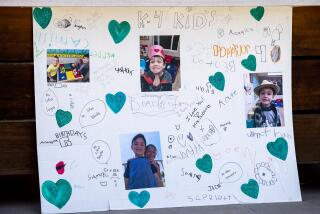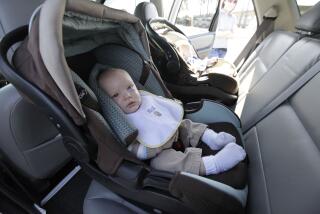Compelling Reasons for Buckling Up
- Share via
I saw something shocking on the freeway the other day.
No, not another grisly wreck or messy spill. And it wasn’t one of those rare scenes that you tell everybody about when you get where you’re going. This was a problem that’s been out there every day, only I just now got around to noticing it.
Whenever I’m stuck in barely-moving traffic, I try to relieve some of the boredom and frustration by finding something of interest in my surroundings. I count expired registrations, read the messages on license plates, frames and bumpers, peek in my next-lane neighbors’ windows to watch them perform personal grooming procedures, or try to figure out what radio station they’re tuned to by the way they’re moving to the beat.
And that’s how I saw it. Suddenly I realized that fewer than half the drivers around me were wearing their seat belts. (My favorite was the guy who was slathering his left arm in sunscreen as he steered his way through stop-and-go traffic. I’m all for saving your skin, but what about the rest of you?)
I guess because I always wear my seat belt--even if I’m just turning around in the driveway--I just assumed most everybody else does, too. Sure, I’ve got a couple of friends who don’t, but they’re kind of odd and I figured that was just one more manifestation. Not so, apparently.
People have all sorts of excuses for not buckling. One friend says he does use his belt, but only on long trips. But three out of four fatal accidents happen within 20 miles of the victim’s home, according to Davine Abbott, program director of the Orange County Trauma Society. More than 80% are at speeds less than 40 m.p.h., and nonbelted fatalities have occurred at speeds as low as 12 m.p.h.
Others say belts are uncomfortable, and they wrinkle your clothes. “Carry a can of wrinkle spray,” Abbott says.
I know what you’re saying: “If she’s going to spend an entire column nagging at me to use my seat belt, I’m turning the page.” Well, it’s true, but stick with me anyway for just a little longer. If you still don’t want to buckle up after you’ve heard me out, I promise not to bring up the subject again.
I used to hate seat belts. I hated the way they felt. I hated the way the car kept beeping at you if you didn’t put them on. I hated the idea that the government or anyone else was telling me what to do in the privacy of my own car. Defiantly, I buckled the belts on my old ’74 Volkswagen behind the seats so that I’d never have to hear the electronic scolding when I started the car.
In the 15 years since then, three things have combined to turn me into a born-again buckler. I became a mother, a paramedic, and an auto accident victim. If not for my seat belt, I might well have become something else: a dead person.
As a novice mother, I still didn’t buckle up, but I carefully strapped my babies into their safety seats whenever I took them anywhere. Unless they cried, in which case I unhooked everything and held them until they quieted down. After all, what harm could come to them in their mother’s arms?
I learned the answer to that question two years later when, as a fledgling paramedic, I saw a 10-month-old girl who had been flung from her mother’s arms out the window, across the highway and into a ditch. All I could do was radio the coroner and try to comfort her stunned parents.
So I became more conscientious about strapping my kids in, even though I refused to do so myself. Only after I saw some of the other things crunched metal could do to human flesh did I give in. You may be reading this over breakfast, so I won’t go into the details.
Let’s just say I was convinced by an overwhelming dose of reality. But even then, I had a brief relapse. One day I reached into the back seat to release my daughter’s belt and it wouldn’t budge. I finally had to get a wrench to unbolt it from the frame and get her out.
It was a freak thing; a petrified French fry was stuck in the works. But I refused to use belts at all for a few weeks, terrified that we could be trapped in a burning or sinking car. Then I had a look at the statistics and realized that wasn’t likely. Less than .05% of all accidents involve fire and/or water, says Abbott.
So I started belting again, although I still won’t let the kids eat French fries in the car.
By January of 1986, I had long since given up paramedic work, but the habit was firmly ingrained. I didn’t need to make any changes to comply with the mandatory seat belt law that went into effect then.
So when another driver plowed into me and pushed me into another car, my seat belt saved me. My car sustained more than $6,000 in damage. I was injured, but I’m here to tell about it.
You think it can’t or won’t happen to you?
In 1987, the most recent year for which statistics are available, there were 577,136 traffic accidents in California, with 360,699 injuries. That breaks down to one accident every 55 seconds, according to Abbott.
Seat belt use has gone up dramatically in recent years, and that’s encouraging. But the bad news is, according to a state study Abbott cited, only about 34% of us are buckling up even now. That’s up from 3% in 1980. For passengers under 5, the rate has gone up from 9% in 1980 to 47% in 1988--but that’s still less than half.
Nationwide, according to a study by the Rand Corporation, 40% of parents surveyed said they never buckle up their children, while 27% said they did “sometimes or once in awhile” and 33% said they did “all or most of the time.
The younger the child, the more likely he or she will be strapped in, according to the Rand study. Nearly two-thirds of children under the age of 1 were seat-belted regularly, compared with only 14% of 5- and 6-year-olds.
In metropolitan areas, children were slightly more likely to be belted, although black and Hispanic children were less likely to be strapped in, according to the Rand study.
Parents who do buckle their children, by the way, are also more likely to be nonsmokers and breast-feeders, which led the Rand researchers to conclude that these parents were concerned about their children’s health.
Do me a favor. Try using those belts for a week. Nobody will think you’re a wimp. Just say you’re participating in an experiment. Then write and let me know how it worked out.
And buckle up the kids, too. If you have a little one, get a car seat appropriate for the child’s size, and use it according to the instructions. Too many parents misuse car seats, strapping them in wrong or not at all, Abbott says. But even a misused car seat can make it 40% less likely that a child will be killed or injured in an automobile accident, she says. That number jumps to 70% if the seat is used correctly.
Use an infant seat facing backward for babies under 20 pounds, Abbott says, and continue using that seat facing forward or a toddler seat until the child reaches 40 pounds. After that, a booster seat can not only make little ones safer but help them see out, which reduces the chance of car sickness.
The Trauma Society, incidentally, offers rental seats at minimal cost for low-income families and short-term rentals for out-of-town visitors. For more information, call 937-5030.
Trucks vs. Cars
Can cars and trucks peacefully coexist on the same roads? Whether you drive a compact car or a big rig, tell us how you feel about those other vehicles who share the freeways with you.
Runnin’ on Empty
Do you wait to fill your tank until there’s nothing left but the fumes? Or do you prefer keeping the gauge on “Full” at all times? Have you ever run out of gas on the road? Tell us all about your gas-buying habits. Full- or self-serve. Brand name or discount. Besides lower prices, what would you like to find at your local gas station?
Send your comments to Life on Wheels, Orange County Life, The Times, 1375 Sunflower Ave., Costa Mesa, Calif. 92626. Please include your phone number so that we can contact you. To protect your privacy, Life on Wheels does not publish correspondents’ last names when the subject is sensitive.
More to Read
Sign up for Essential California
The most important California stories and recommendations in your inbox every morning.
You may occasionally receive promotional content from the Los Angeles Times.










